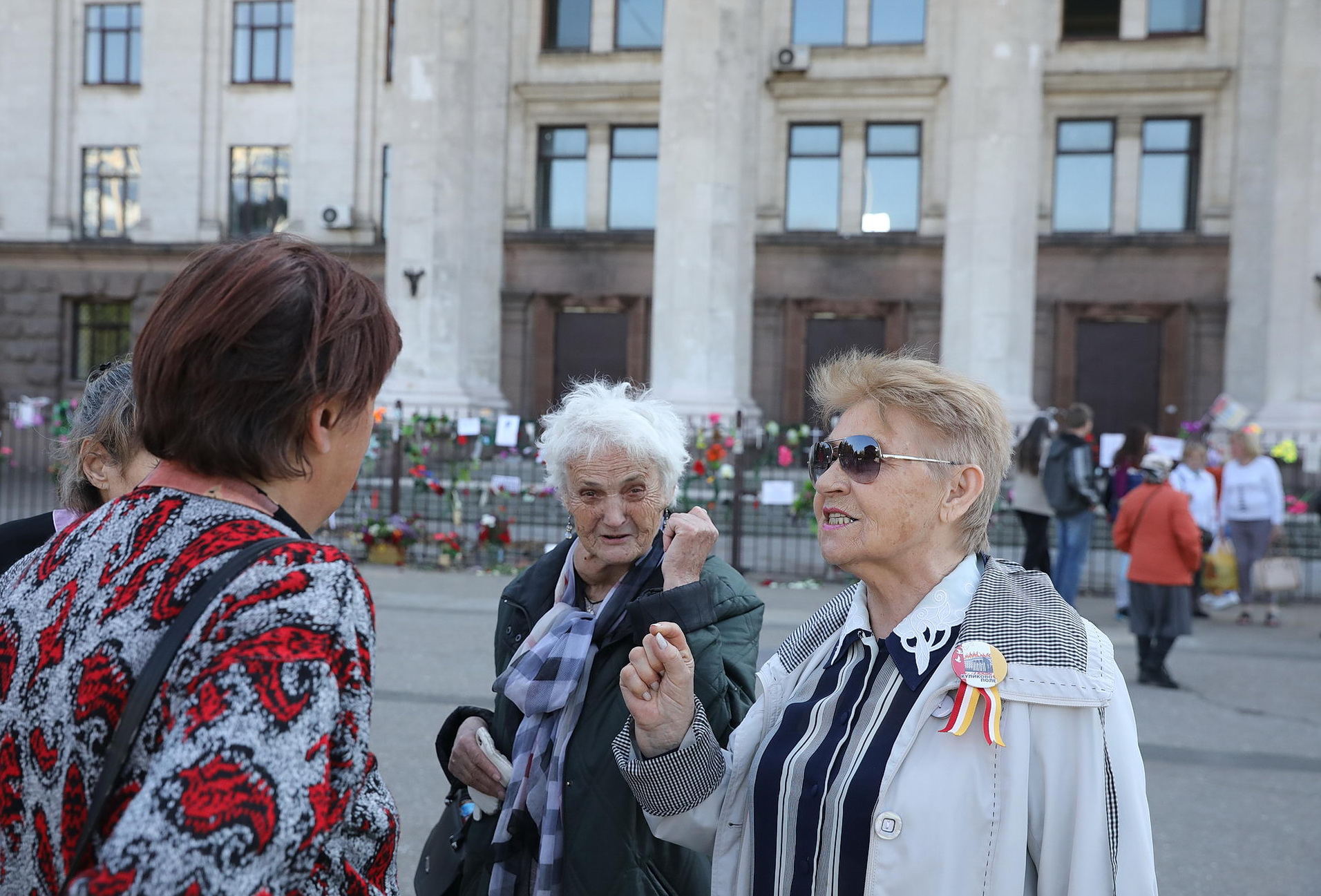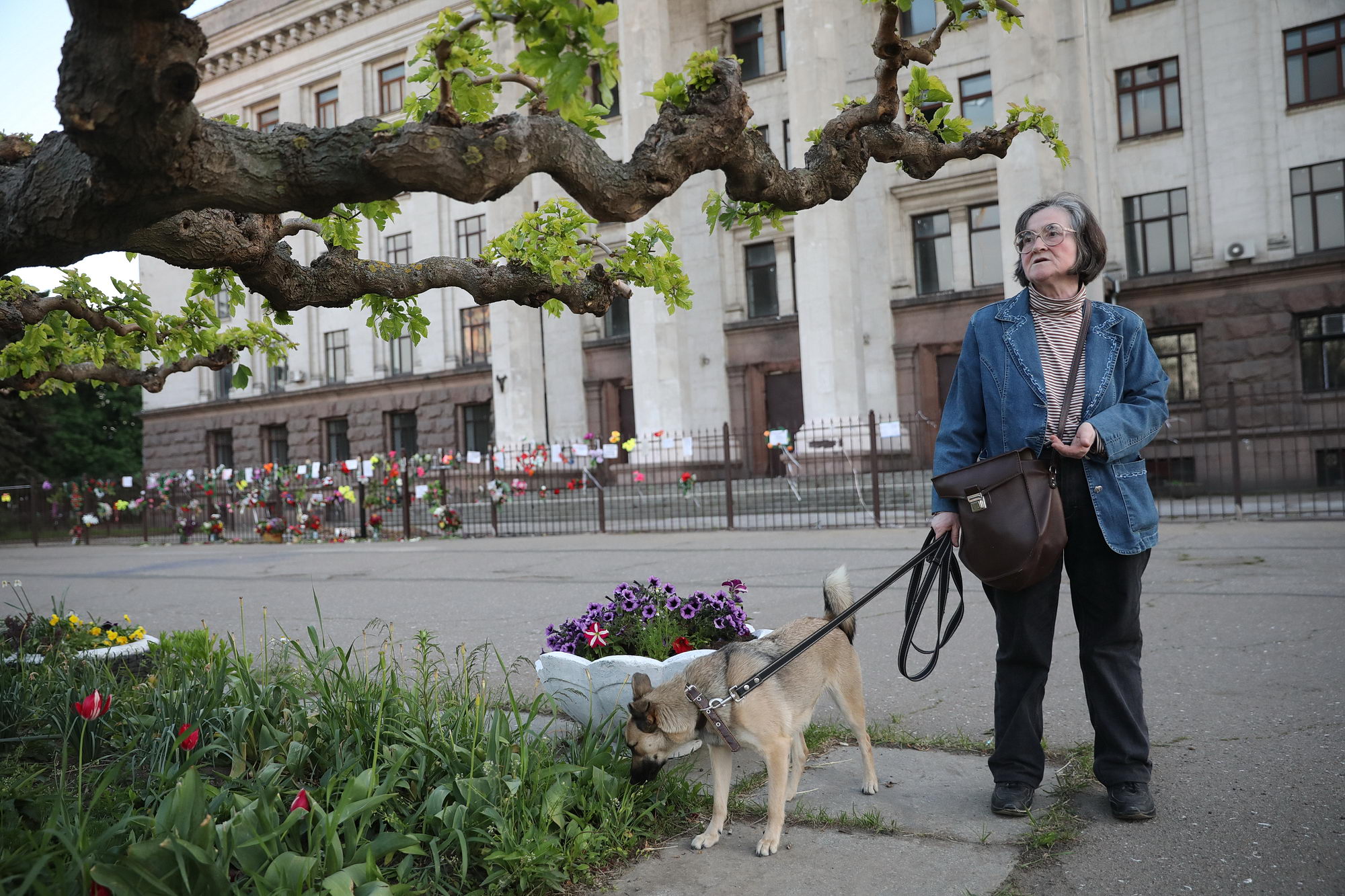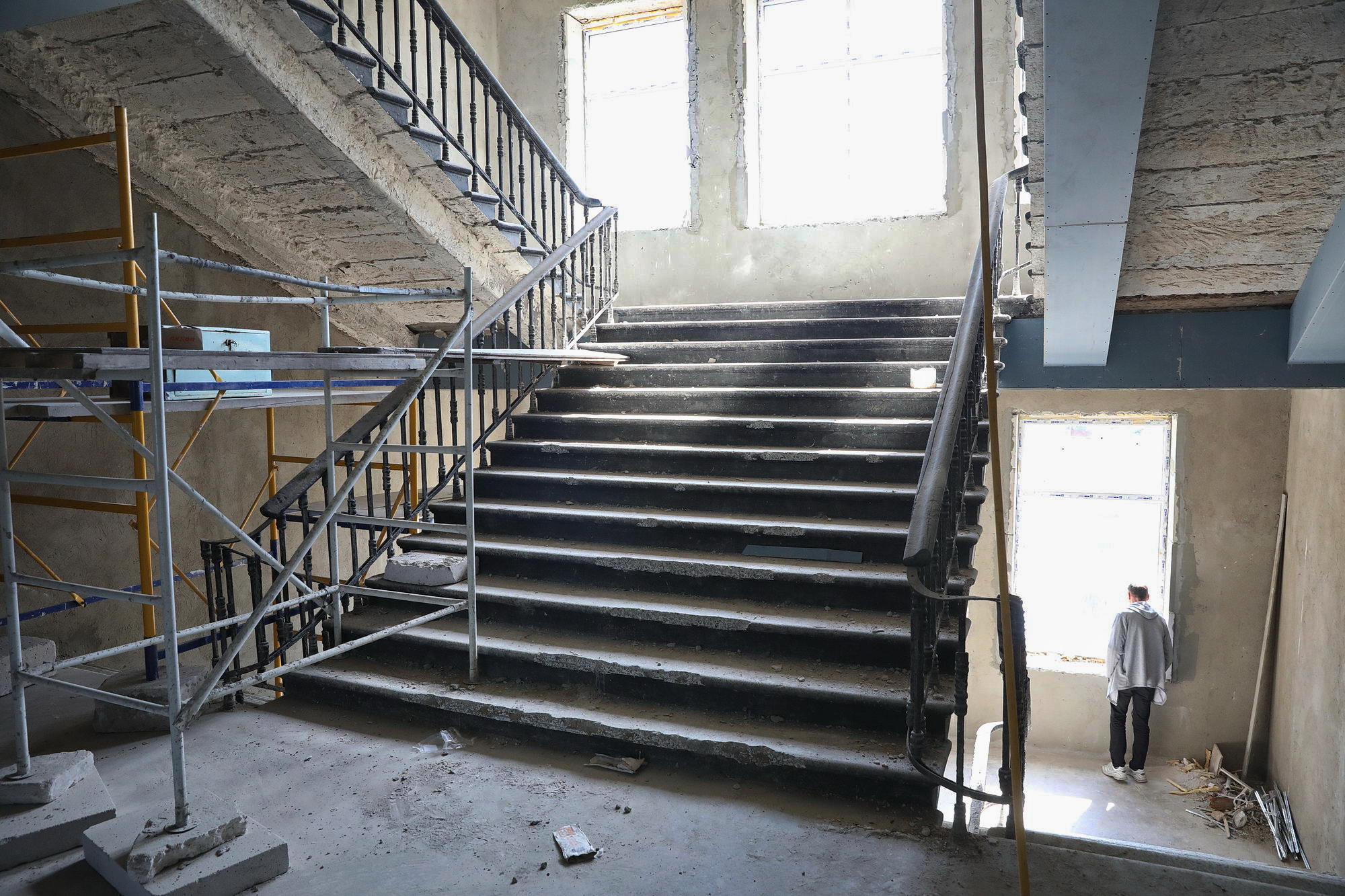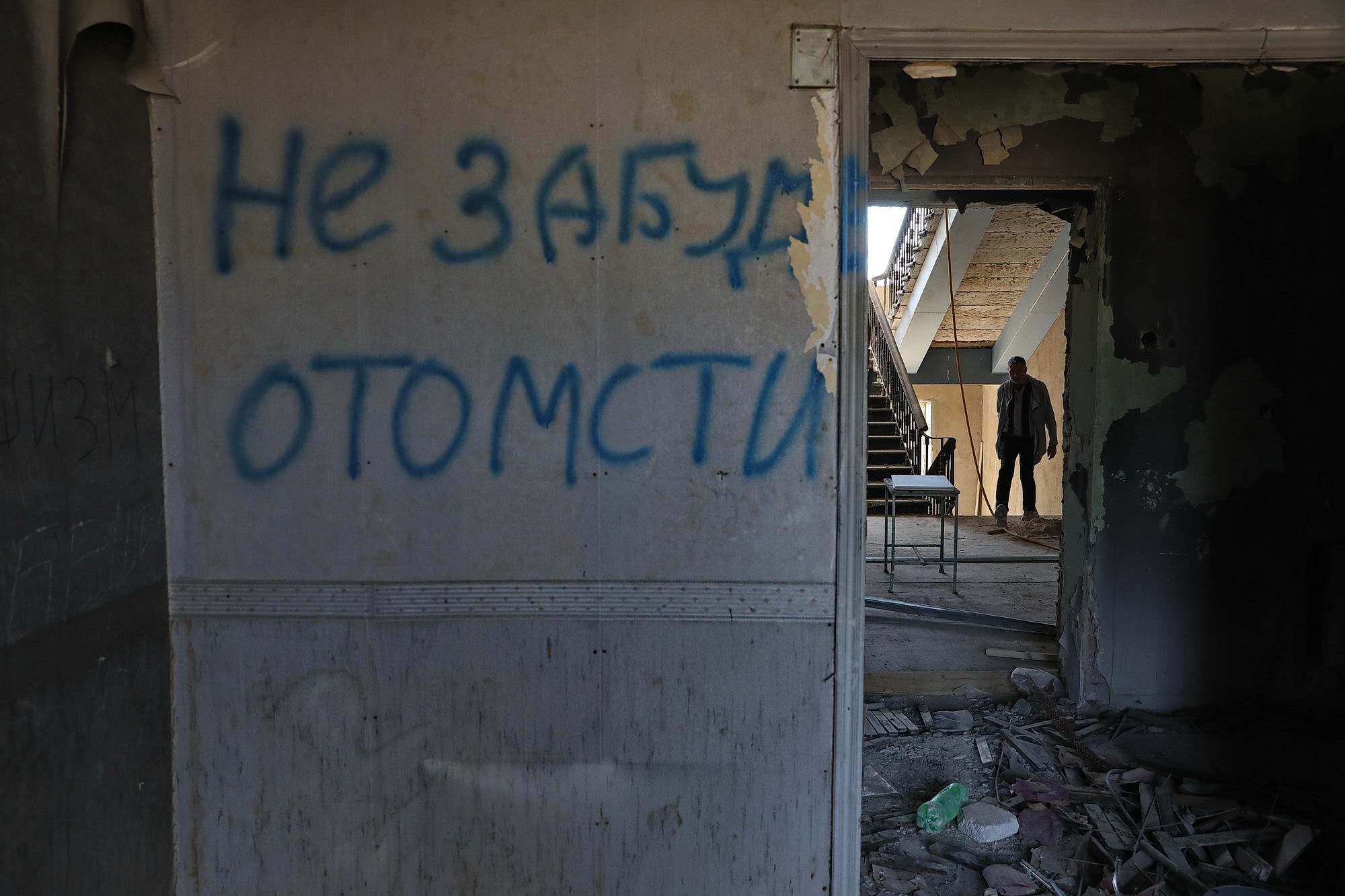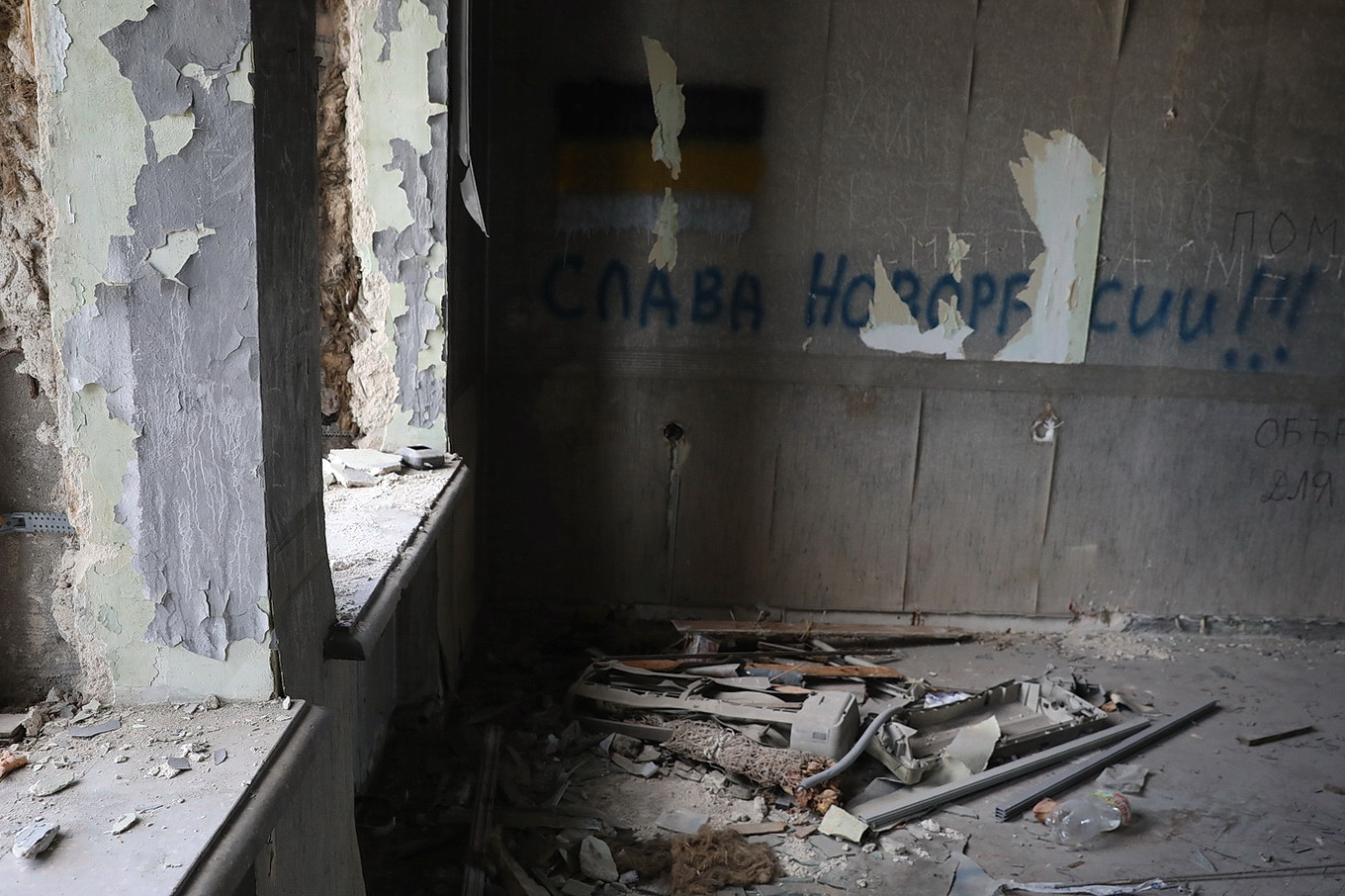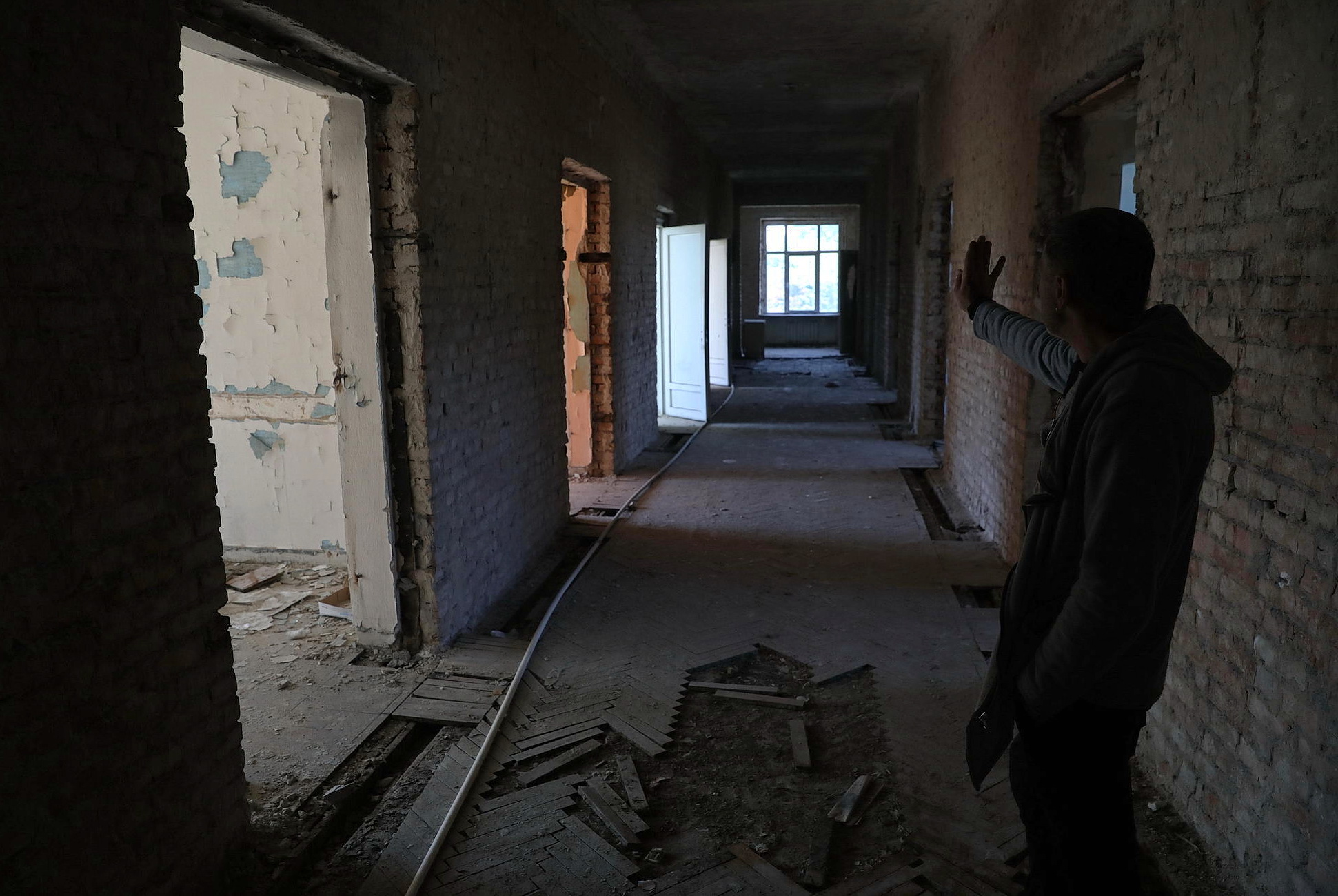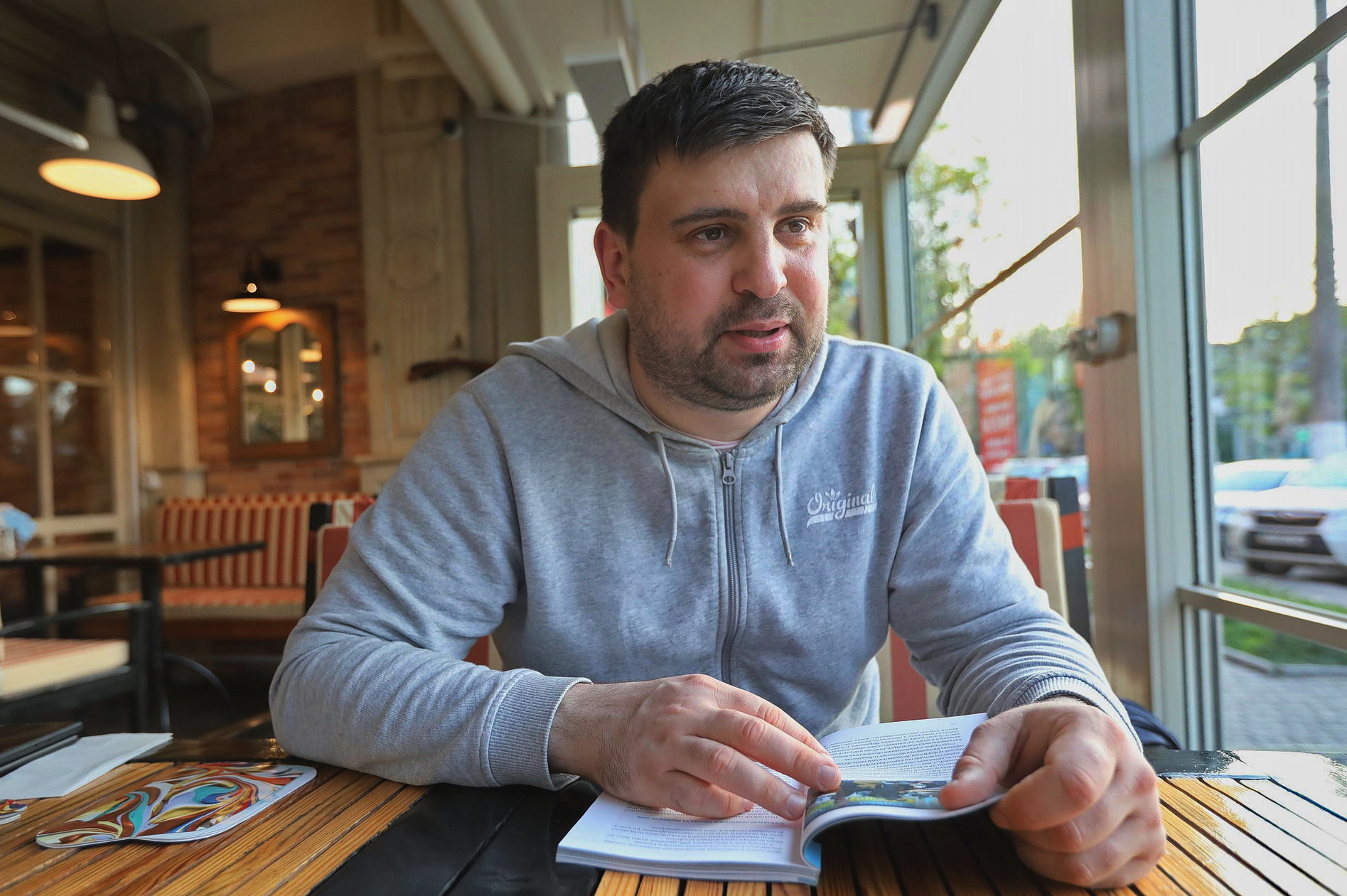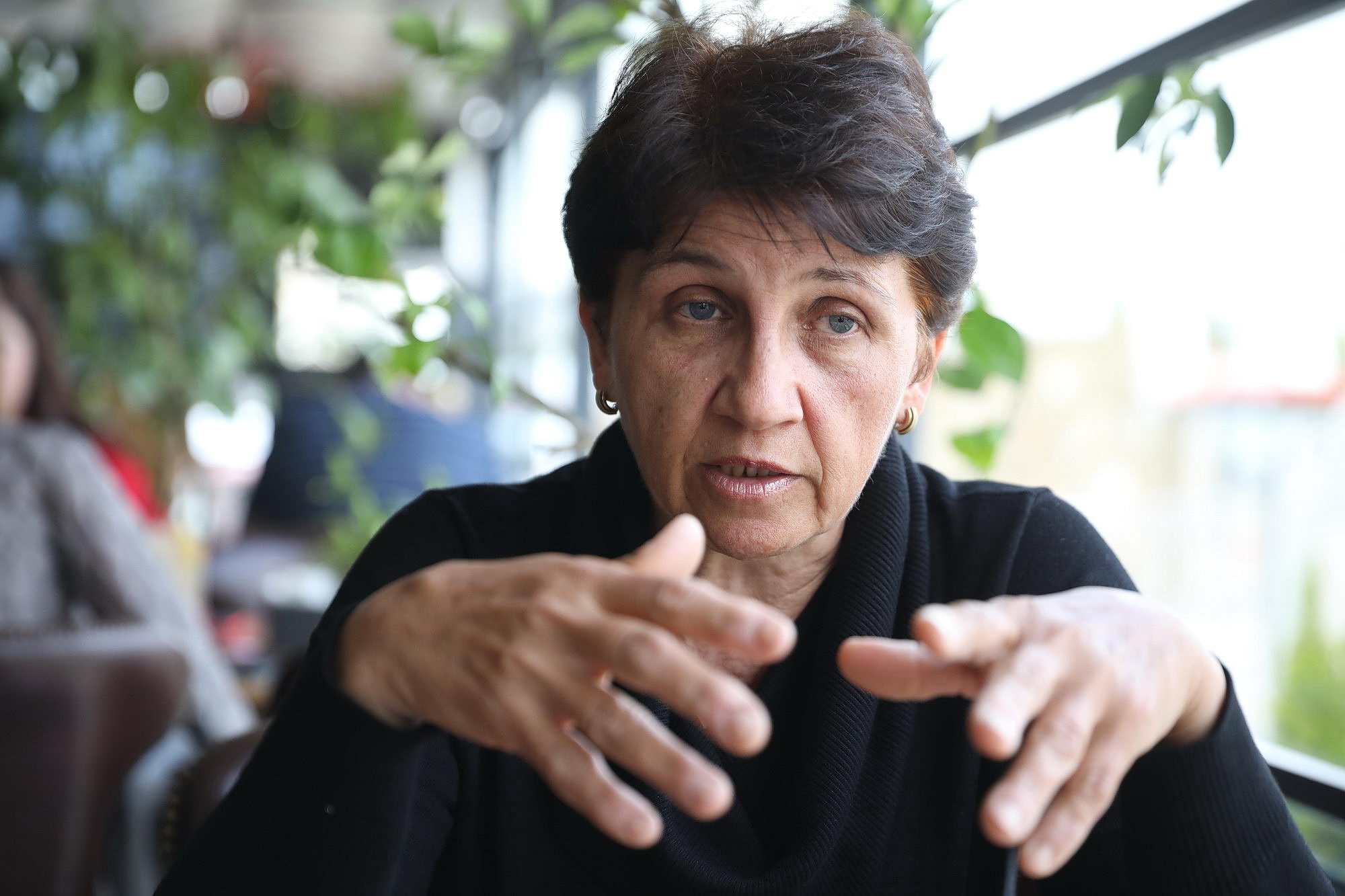ODESA, Ukraine — Every Sunday, a dozen people come to the Trade Unions House in Odesa. They bring candles and flowers to commemorate the 48 people who were killed there on May 2, 2014, a time of heightened fears over the possibility of a full-scale invasion of Ukraine from Russia.
On that day, Odesa, the Black Sea port city of 1 million people located 470 kilometers southwest of Kyiv, transformed into a battlefield between pro-Ukrainian and pro-Russian activists. It ended with bloodshed: Six people were shot dead in the city streets, 32 were killed in a fire at the Trade Unions House and more 10 lost their lives while trying to escape the blaze by jumping or falling out of windows.
It was a tragic event that shook the nation. At that time, Russia had already seized Crimea and parts of the eastern Donbas region. Soon after, the Kremlin would use the Odesa catastrophe to recruit volunteers to instigate a broader insurrection against Kyiv — after all, 46 of the 48 victims were identified as pro-Russian activists.
Five years on, only a small group of people — predominantly survivors and relatives of those killed — are still pushing for justice.
With no clear answers from Ukrainian law enforcement, the people who come to the Trade Unions House still share the Russian conspiracy theory that the Security Service of Ukraine used gas to deliberately kill people in the building.
Meanwhile, pro-Ukrainian activists pay tribute to two young men killed on May 2 from the Ukrainian side. Their portraits hang on a fence downtown, three kilometers from Trade Unions House, where people leave flowers. Their supporters have their own theory: that the fire in the Trade Unions House was orchestrated by the Russian security services and that many of the people killed there were Russian nationals.
Separately, a group of journalists and experts have joined together and conducted an independent investigation. They call themselves the May 2 Group, and say they have many of the answers.
“This was a horrible accident,” Tetiana Gerasymova, coordinator of the May 2 Group, told the Kyiv Post.
She believes the local police and emergency services chiefs could have prevented such a high death toll, but they simply did not.
But the May 2 Group’s explanation of the tragedy appears to be of little interest to law enforcement. In a report published on May 2 this year, the United Nations Human Rights Monitoring Mission to Ukraine cited “a lack of genuine interest from the authorities to ensure justice for victims and accountability for perpetrators.”
Many people investigated for alleged involvement in the Odesa tragedy — both by law enforcement and the May 2 Group — have long left for Russia or Russian-controlled territories.

Odessa’s Trade Unions House burns on May 2, 2014. The 42 people were killed by the fire there, following the street fights between the pro-Russian and pro-Ukrainian activists. The total number of those killed on that day from both sides is 48. (UNIAN)
How it happened: Downtown
In April 2014, only two months after the EuroMaidan Revolution overthrew pro-Kremlin President Viktor Yanukovych, pro-Moscow rallies against the new government in Kyiv rocked Odesa and other southern and eastern cities. Pro-Kyiv activists also came out to rally in support of the new Ukrainian government and against the Russian invasion of Ukraine.
Excited by Russia’s annexation of Crimea and possibly sponsored by the Russian government, pro-Russian activists set up a tent camp at Kulykove Field square, located next to the Trade Unions House, which had served as Communist Party headquarters in Soviet times.
Pro-Ukrainian activists regularly rallied near the monument to Duke de Richelieu, the first governor of the city.
On May 2, Odesa hosted a soccer match between the local Chornomorets club and Kharkiv Metalist. Fans of both teams, along with local pro-Ukrainian activists, planned to march for national unity before the game.
Tetiana Soykina, 28, an activist from the Ukrainian Right Sector nationalist group, came in the afternoon to Soborna Square, where about 2,000 people, including many women and children, were gathering to start the unity rally. She left her body armor vest at home, not expecting any serious clashes.
But around 3:30 p. m., fights broke out when about 300 members of the pro-Russian Odesa Squad led by Serhiy Dolzhenkov abruptly changed the direction of their march and attacked the pro-Ukrainian activists with stones, stun grenades and smoke bombs. Street clashes erupted.
“The thunder flashes, smoke bombs were flying all through the air,” Soykina remembers.
A young man gave her his helmet. Activists started using Molotov cocktails, then unexpected gunfire rang out.
Police cordons were of little help. “On May 2, state authority wasn’t present in Odesa,” activist Vitaliy Ustymenko, who leads the Odesa branch of the Automaidan protest movement, told the Kyiv Post.
Within an hour, Soykina saw EuroMaidan activist Andriy Biriukov with a gunshot wound to this chest. It proved to be fatal. Right Sector’s Ihor Ivanov, with whom Soykina had traveled to Kyiv’s EuroMaidan protest, received a fatal bullet wound to his stomach.
“They killed my friend,” Soykina said.
A YouTube video shows that pro-Russian activist Vitaly Budko was shooting from behind the police cordon.
Later, four pro-Russian activists were shot dead amid street fights, while several police officers and journalists were wounded.
“Why did they kill him? He loved life so much,” said Iryna Petrova, mother of Hennady Petrov, a 29-year-old pro-Russian activist, who was fatally wounded.
With fights still raging, some pro-Ukrainian activists headed to Kulykove Field to demolish the pro-Russian encampment.
How it happened: Kulykove Field
Vera Butuk, 62, a pensioner, came early on that day to the pro-Russian camp at Kulykove Field with her brother and a small placard reading “EuroMaidan will kill Ukraine.” By late afternoon, the pro-Russian activists had received word of the killings downtown. They were told that pro-Kyiv activists were coming for them, and they began to panic. Many fled.
Others decided to hide in the Trade Unions House. Butuk was one of them. “This building is so big, with thick walls,” she said. “We didn’t think something would happen there. At a maximum, the windows would be smashed.”
The pro-Russian activists broke into the building and brought some Orthodox icons, clothes, papers, plywood and even a petrol generator that was producing electricity for the tent camp. All these items were stored by the stairs on the first and second floors, which later helped the fire to spread quickly.
There were about 400 people hiding in the building. At least some of them were armed with guns and Molotov cocktails.
The pro-Ukrainian activists came to the camp at about 7:20 p. m. and started smashing the tents, setting them on fire, throwing stones and Molotov cocktails at the Trade Unions House. Those inside threw Molotov cocktails back. Gunfire came from both sides.
Butko said a Molotov cocktail ignited the curtains of a window in the second-floor room where she was hiding, but someone was able to extinguish the fire.
The main fire, however, started on the left side of the first floor at 7:44 p. m., according to the findings of the May 2 Group. It spread rapidly as people smashed windows for air, according to the May 2 Group’s investigation. Some died from fire or smoke inhalation. Some died after falling or jumping from windows.
Firefighters began to extinguish the blaze only 40 minutes after the fire started, despite dozens of emergency calls and a fire station located just around the corner.
Butko said she and dozens of other people hid in a back room in the right wing of the building. They closed the door to the main corridor and opened a window. She believes some type of gas was deliberately used to kill people.
But experts of the May 2 Group — which includes doctors, chemists, and toxicologists — found no evidence of gas or any other toxic chemicals that could cause the deaths.
Butko managed to descend from the second floor using a ladder brought by firefighters. That saved her life.
Many pro-Ukrainian activists rescued people from the fire. Others, however, beat and insulted those who escaped from the Trade Unions House, according to videos from the scene.
Shock
On the next morning, May 3, 2014, anybody who wanted could come to the Trade Unions House and see dozens of dead bodies. Some bodies of pro-Russian activists lay on the asphalt, covered in Ukrainian national flags.
Gerasymova of the May 2 Group remembers a city in silent shock. People even did not talk on public transport.
The youngest victim of the fire was Vadym Papura. He was just 17.
Most of the victims of the fire turned out to be residents of Odesa or Odesa Oblast.
“Young boys were killed. This tragedy, this pain has sharply divided us,” Butuk said. She says she mourns victims on both sides.
But Soykina doesn’t have any sympathy for victims of the fire. “They attacked us first,” she said. “Do you ask soldiers if they feel sorry about their enemies? This is the same.”
Soykina, who fought against Russia in the Donbas in 2014-2015, now heads Right Sector in Odesa.
Investigation
On May 4, 2014, a crowd of about 1,000 city residents came to the police detention center in Odesa to demand the release of pro-Russian activists who had been arrested. With shouts of “Freedom!” they smashed the small windows of the detention center’s front gate and achieved their goal. The gate opened and 67 people walked free.
After the incident, the city police chief, the head of the detention center and a police officer on duty that day were arrested for allowing these people to leave. Gerasymova believes they were made scapegoats. “They just needed to punish someone,” she said.
She believes the former Odesa Oblast deputy police chief, Dmytro Fuchedzhy, ordered the release of the pro-Russian protesters. Fuchedzhy also coordinated police efforts on May 2. Later, the three former police officers were released on bail. Their case has been stalled since 2014.
On May 7, 2014, Ukraine’s top cop, Interior Minister Arsen Avakov, reported that Fuchedzhy had gone into hiding in Transnistria, the Russian-controlled part of Moldova. In interviews with Russian media, Fuchedzhy accused Ukraine’s state and regional authorities of masterminding the violence on May 2.
The former deputy chief of the regional emergency services, the head of the emergency duty shift and the emergency phone operator also all became scapegoats. They have been accused of delaying the dispatch of fire brigades to the Trade Unions House on May 2. But a police investigation found that they acted on the orders of oblast emergency chief Volodymyr Bodelan, who fled Ukraine. Their cases — along with that of Ruslan Velyky, Bodelan’s former deputy — have been stalled in court since 2016.
In 2017, Ukrainian media reported that Bodelan had obtained a high position in the emergency services of Russian-annexed Crimea. In a statement to the May 2 Group, Bodelan claimed that protesters hindered the work of firefighters.
In 2015, prosecutors also opened a case against Petro Lutsiuk, the former Odesa Oblast police chief, accusing him of not taking efforts to stop the bloodshed on May 2 and falsifying documents to indicate that he supposedly implemented a special police operation to stop the street fights.
Lutsiuk now lives in Lutsk, a city of 217,000 people roughly 400 kilometers to the west of Kyiv, and only visits Odesa for court hearings, which are still ongoing. In an interview with the NewsOne TV channel, Lutsiuk said he had done all that he could to stop the violence, but many police officers were “demoralized” after EuroMaidan in Kyiv and were scared to act more decisively.
“Fuchedzhy, Bodelan, and Lutsiuk are the main people responsible,” said Pavlo Polmarchuk, an Odesa activist who contributed to the May 2 Group investigation. He also blames Dmytro Tsvetkov, a former chief investigator of the Odesa police, for allowing anybody to enter the Trade Unions House after the fire, possibly destroying or tampering with evidence. A downtown cleaning crew had also removed evidence of the shootings. In 2018, Ukrainian media reported that Tsvetkov was hiding in Moscow.
Gerasymova believes a court made the right decision in September 2017 to release 19 pro-Russian activists accused of involvement in the bloodshed downtown on May 2 due to a “lack of evidence of their guilt.” She says prosecutors had indeed failed to prove they were guilty.
However, the court immediately ruled to re-arrest two of these 19 people — Dolzhenkov, who directed a crowd to attack a pro-Ukrainian march on May 2, and Russian national Yevgeny Mefedov. Both men have been accused of instigating anti-government riots in Mykolaiv, a city 130 kilometers to the northeast of Odesa, where they now remain in custody.
In their research, the May 2 Group experts say that it is still unclear why Dolzhenkov decided to start the violence in Odesa, by redirecting his march toward the pro-Ukrainian protest.
Activist Ustymenko calls Dolzhenkov an “honest enemy” and a true believer in the so-called Russian World.

On May 2, 2014, 48 people were killed in Odesa clashes between pro-Russian and pro-Ukrainian demonstrators. Six deaths came after street fights downtown. Following the fights, pro-Russian protesters hid in the Trade Unions House, where another 42 people were subsequently killed in a fire. (Google, Kyiv Post )
“I presume his coordinators in Russia may have called him and ordered him to start those actions,” Ustymenko said. “He led his group, with arms, relying on the neutrality of the police and hoping to change the situation.”
Pro-Ukrainian activist Sehiy Khodiyak is now on trial for killing pro-Russian activist Yevhen Losinsky and wounding several other people. The trial has been ongoing since 2015. Meanwhile, Khodiyak remains free and has occasionally attacked critics of Odesa Mayor Gennady Trukhanov, Ustymenko said. Gerasymova said she had received threats from Khodiyak.
Pro-Russian shooter Budko, who is suspected by May 2 Group experts of killing Ivanov, reportedly went into hiding in Russian-controlled Transnistria.
The Odesa tragedy has only resulted in one criminal sentence so far: a five-year prison term in absentia for Denys Yatsiuk, one of the leaders of the pro-Russian Odesa Squad. He is currently hiding in Russian-occupied parts of the Donbas and calls himself a “war correspondent” in interviews with Russian media.
Meanwhile, some relatives of those killed on May 2 are now planning to lodge a complaint with the European Court of Human Rights.
Gerasymova says national courts often just imitate work. Thus, domestic court proceedings are “just a waste of time and money,” she said.
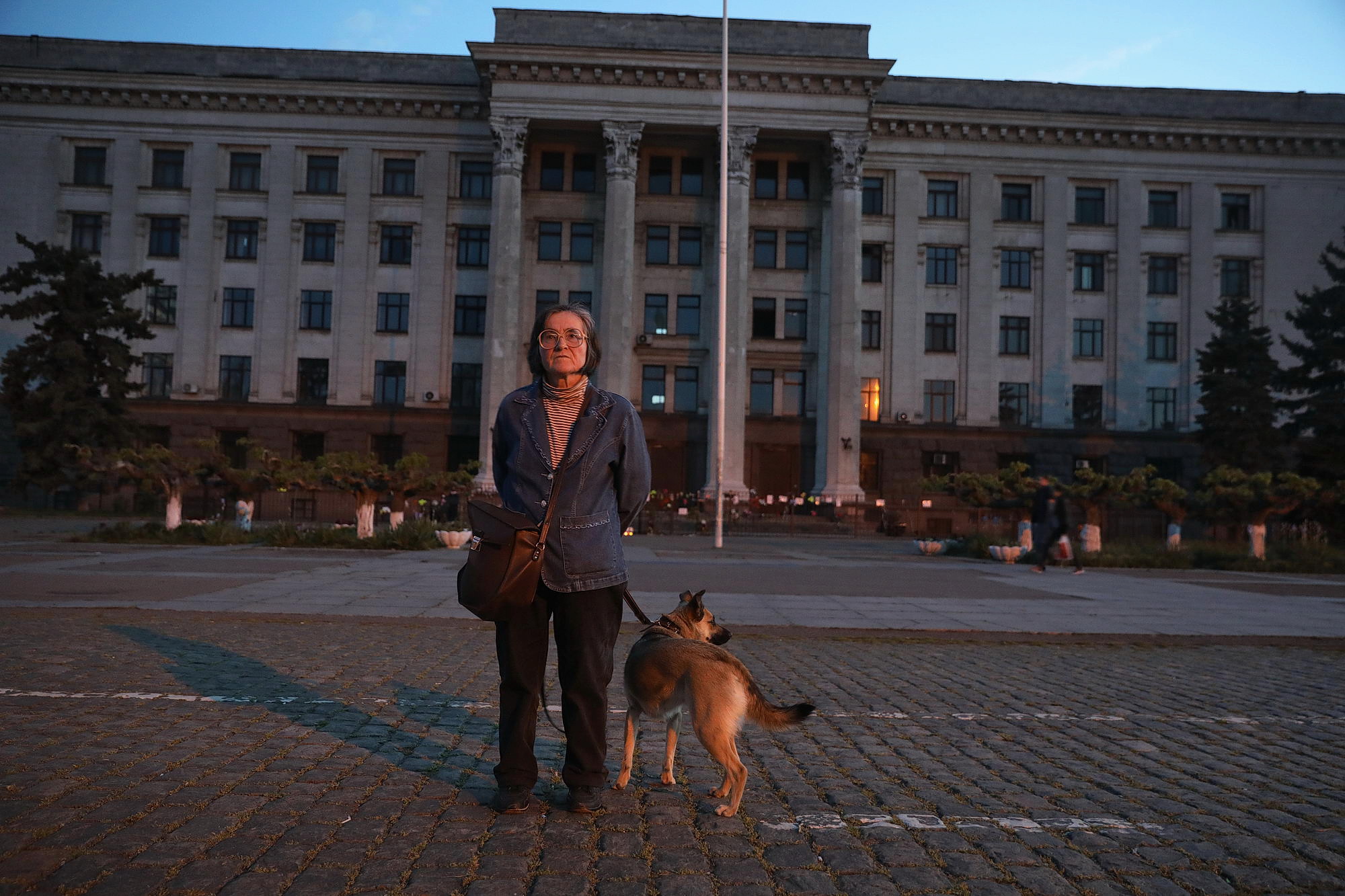
Pro-Russian activist Vera Butuk stands with her dog by the Trade Unions House in Odesa on May 12, 2019. She comes here almost every day to lit the candles in memory of 42 people who were killed by fire in that building on May 2, 2014. Butuk is one of the survivors from that fire. (Kostyantyn Chernichkin)
Top 5 myths about Odesa May 2 tragedy
1. Hundreds were killed in Trade Unions House
Truth: Although many pro-Russian activists still talk about hundreds of victims in the May 2, 2014 fire, law enforcement, medics and experts of the independent May 2 Group have concluded that 42 people died there out of 48 killed that day.
2. There were many Russian nationals among victims of the fire
Truth: The majority of the people who died in the Trade Unions House were residents of Odesa or Odesa Oblast, according to the investigation of the May 2 Group. There were no Russian nationals among them.
3. Gas or another toxic substance was used in Trade Unions House to spread the fire
Truth: The experts of the May 2 Group — including medics, chemists and toxicologists who inspected the building — say there was no sign of gas or other toxic substances deliberately spread there. They suggest the fire spread rapidly because of the building’s high ceilings and the air flow, which intensified after people smashed windows to be able to breathe. The temperature there reached 400-600 degrees Celsius, which caused many deaths from burns or from breathing in the extremely hot air.
4. People were killed by firearms in Trade Unions House
Truth: Pro-Russian activists still share stories that many of those who died in the Trade Unions House were shot dead by pro-Ukrainian activists in the building. But medics and experts of the May 2 Group who examined the bodies say none of the people killed there had gunshot wounds.
5. Pro-Ukrainian protestors cut the firehoses, prevented the work of firefighters
Truth: Pro-Russian activists and some former state emergency officials say that pro-Ukrainian protesters prevented the firefighters from getting to the burning Trade Unions House and even cut the firehoses. Experts of the May 2 Group say that many pro-Ukrainian activists were actually trying to save those trapped in the burning building and helped the firefighters. YouTube videos prove this version of the story.





